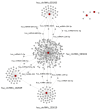A Plasma Circular RNA Profile Differentiates Subjects with Alzheimer's Disease and Mild Cognitive Impairment from Healthy Controls
- PMID: 36362022
- PMCID: PMC9658433
- DOI: 10.3390/ijms232113232
A Plasma Circular RNA Profile Differentiates Subjects with Alzheimer's Disease and Mild Cognitive Impairment from Healthy Controls
Abstract
The most frequently used biomarkers to support the diagnosis of Alzheimer’s Disease (AD) are Aβ42, total-Tau, and phospho-tau protein levels in CSF. Moreover, magnetic resonance imaging is used to assess hippocampal atrophy, 18F-FDG PET to identify abnormal brain metabolism, and PET imaging for amyloid deposition. These tests are rather complex and invasive and not easily applicable to clinical practice. Circulating non-coding RNAs, which are inherently stable and easy to manage, have been reported as promising biomarkers for central nervous system conditions. Recently, circular RNAs (circRNAs) as a novel class of ncRNAs have gained attention. We carried out a pilot study on five participants with AD and five healthy controls (HC) investigating circRNAs by Arraystar Human Circular RNA Microarray V2.0. Among them, 26 circRNAs were differentially expressed (FC ≥ 1.5, p < 0.05) in participants with AD compared to HC. From a top 10 of differentially expressed circRNAs, a validation study was carried out on four up-regulated (hsa_circRNA_050263, hsa_circRNA_403959, hsa_circRNA_003022, hsa_circRNA_100837) and two down-regulated (hsa_circRNA_102049, hsa_circRNA_102619) circRNAs in a larger population. Moreover, five subjects with mild cognitive impairment (MCI) were investigated. The analysis confirmed the upregulation of hsa_circRNA_050263, hsa_circRNA_403959, and hsa_circRNA_003022 both in subjects with AD and in MCI compared to HCs. We also investigated all microRNAs potentially interacting with the studied circRNAs. The GO enrichment analysis shows they are involved in the development of the nervous system, and in the cellular response to nerve growth factor stimuli, protein phosphorylation, apoptotic processes, and inflammation pathways, all of which are processes related to the pathology of AD.
Keywords: AD; Alzheimer Disease; MCI; biomarkers; circRNA; circular RNA; microarray Real-Time PCR; mild cognitive impairment.
Conflict of interest statement
The authors declare no conflict of interest.
Figures









Similar articles
-
Circulating plasma circular RNAs as novel diagnostic biomarkers for congenital heart disease in children.J Clin Lab Anal. 2019 Nov;33(9):e22998. doi: 10.1002/jcla.22998. Epub 2019 Aug 20. J Clin Lab Anal. 2019. PMID: 31429492 Free PMC article.
-
Whole Transcriptome Sequencing of Peripheral Blood Identifies the Alzheimer's Disease-Related circRNA-miRNA-lncRNA Pathway.Curr Neurovasc Res. 2024;21(2):184-197. doi: 10.2174/0115672026305417240209062508. Curr Neurovasc Res. 2024. PMID: 38482622
-
[Differences in circRNA expression profiles between HER-2-positive breast cancer cells and normal mammary epithelial cells].Zhonghua Zhong Liu Za Zhi. 2019 May 23;41(5):331-337. doi: 10.3760/cma.j.issn.0253-3766.2019.05.003. Zhonghua Zhong Liu Za Zhi. 2019. PMID: 31137165 Chinese.
-
Dynamics and role of covalently-closed circular RNAs in Alzheimer's disease: A review of experimental and bioinformatics studies.Neurobiol Aging. 2025 Jul;151:54-69. doi: 10.1016/j.neurobiolaging.2025.04.002. Epub 2025 Apr 11. Neurobiol Aging. 2025. PMID: 40239316 Review.
-
Exosomes and non-coding RNAs: bridging the gap in Alzheimer's pathogenesis and therapeutics.Metab Brain Dis. 2025 Jan 4;40(1):84. doi: 10.1007/s11011-024-01520-7. Metab Brain Dis. 2025. PMID: 39754674 Free PMC article. Review.
Cited by
-
CircITSN1/EIF4A3/Itsn1 axis mediates postoperative cognitive dysfunction in aged mice: A novel mechanism and therapeutic target.Mol Ther Nucleic Acids. 2025 May 8;36(2):102555. doi: 10.1016/j.omtn.2025.102555. eCollection 2025 Jun 10. Mol Ther Nucleic Acids. 2025. PMID: 40487353 Free PMC article.
-
Circular RNAs in neurological conditions - computational identification, functional validation, and potential clinical applications.Mol Psychiatry. 2025 Apr;30(4):1652-1675. doi: 10.1038/s41380-025-02925-1. Epub 2025 Feb 17. Mol Psychiatry. 2025. PMID: 39966624 Free PMC article. Review.
-
Prenatal alcohol exposure dysregulates spinal and circulating immune cell circular RNA expression in adult female rats with chronic sciatic neuropathy.Front Neurosci. 2023 Jun 9;17:1180308. doi: 10.3389/fnins.2023.1180308. eCollection 2023. Front Neurosci. 2023. PMID: 37360167 Free PMC article.
-
Are Ischemic Stroke and Alzheimer's Disease Genetically Consecutive Pathologies?Biomedicines. 2023 Oct 8;11(10):2727. doi: 10.3390/biomedicines11102727. Biomedicines. 2023. PMID: 37893101 Free PMC article. Review.
-
Biofluid biomarkers for Alzheimer's disease: past, present, and future.Med Rev (2021). 2024 Oct 17;4(6):467-491. doi: 10.1515/mr-2023-0071. eCollection 2024 Dec. Med Rev (2021). 2024. PMID: 39664082 Free PMC article. Review.
References
-
- Grimmer T., Wutz C., Alexopoulos P., Drzezga A., Förster S., Förstl H., Goldhardt O., Ortner M., Sorg C., Kurz A. Visual Versus Fully Automated Analyses of 18F-FDG and Amyloid PET for Prediction of Dementia Due to Alzheimer Disease in Mild Cognitive Impairment. J. Nucl. Med. 2016;57:204–207. doi: 10.2967/jnumed.115.163717. - DOI - PubMed
-
- Jack C.R., Bennett D.A., Jr., Blennow K., Carrillo M.C., Dunn B., Haeberlein S.B., Holtzman D.M., Jagust W., Jessen F., Karlawish J., et al. NIA-AA Research Framework: Toward a biological definition of Alzheimer’s disease. Alzheimers Dement. 2018;14:535–562. doi: 10.1016/j.jalz.2018.02.018. - DOI - PMC - PubMed
MeSH terms
Substances
Grants and funding
LinkOut - more resources
Full Text Sources
Medical

